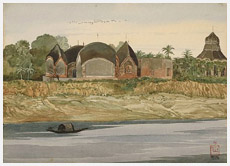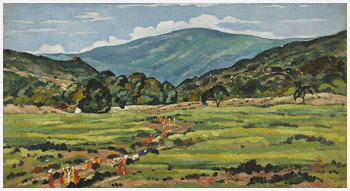INDRA
DUGAR
|
| |
|
| |

1918 - 1989

|
| |
|
| |
|
|
|
 |
Artist Profile |
BEGINNINGS
Born in Jiaganj, West Bengal. Member, Academy of Fine
Arts, Calcutta. Member, AIFACS, New Delhi. 1939, 49,
56 Commissioned to decorate annual sessions of Congress
in Ramgarh, Jaipur and Amritsar. 1944 First Prize for
card design, The Patra All India Exhb. 1945, 49, 50
Silver Medal, Academy of Fine Arts, Calcutta. Gold Medal,
University Institution Exhb., Calcutta. 1981, 82 Award,
West Bengal Academy of Dance, Drama, Music and Fine
Arts, Calcutta. Founder member, Murshidabad Sangha.
1986 Received 8th Sangeet Shyamala Award, Calcutta.
Illustrated a number of childrens books. Art Critic
in Bengali journals like Desh and Ananda Bazar Patrika.
The Indian Embassy presented one of his paintings to
Govt. of USSR.
|
| |
EDUCATION
- Self-taught artist with no academic training in
art.
- Early art education under his father, Hirachand
Dugar.
- Studied under the tutelage of Nandalal Bose.
EXHIBITIONS
- 1945 Exhibited regularly, Academy of Fine Arts,
Calcutta.
- 1946 Exhb., United Kingdom.
- 1946 International Modern Art, organised by UNESCO,
Paris.
- 1949, 75 Solo exhb., Calcutta.
- 1954, 65, 77 Exhb., Jiaganj, Murshidabad.
- 1955, 56 Exhb. of Indian Art, organised by Lalit
Kala Akademi, Czechoslovakia, Romania and Bulgaria.
- 1959 Solo exhb., inaugurated by President Dr. S.
Radhakrishnan, New Delhi.
- 1964 Solo exhb. sponsored by Lufthansa and Deutschewelle,
West Germany.
- 1968 Exhb., Kala Bhavan, Santiniketan.
- 2004 Manifestations II, organised by Delhi Art Gallery,
Jehangir Art Gallery, Mumbai and Delhi Art Gallery,
New Delhi.
- 2005 Manifestations III, organised by Delhi Art
Gallery, Nehru Center, Mumbai and Lalit Kala Akademi,
New Delhi.
COLLECTION
- Birla Academy of Art and Culture, Kolkata.
- National Gallery of Modern Art, New Delhi.
- Academy of Fine Arts, Kolkata.
- AIFACS, New Delhi.
- Sahitya Kala Parishad, Patna.
- Amar Mahal Museum, Kashmir.
- Delhi Art Gallery, New Delhi.
STYLE
When in the 60s, the Bengal School strayed into the
backwater of the Indian art scene, Indra Dugar was one
of the few who fought to enrich the tradition with fresh
vigour and vividness as witnessed in this painting.
True to the ideal of the Bengal School, Indra Dugars
quest is not only for the past enshrined in the present
but also in its transforming into the timeless.

back |
| |
|
|
|



